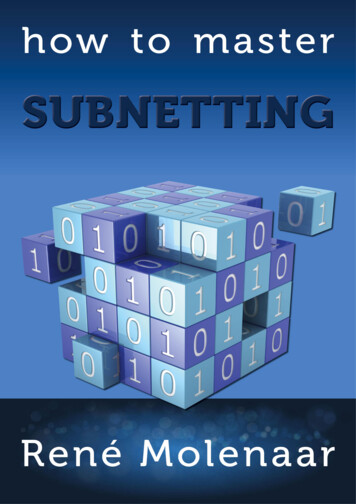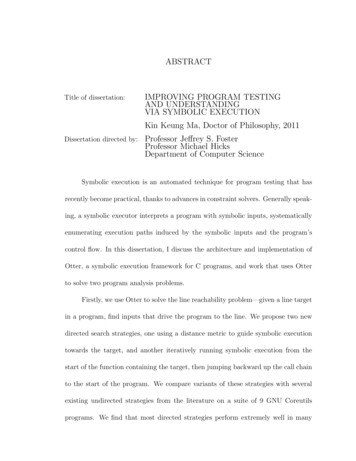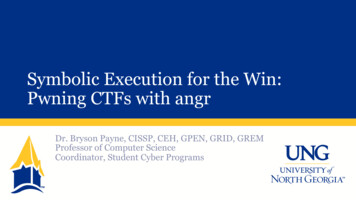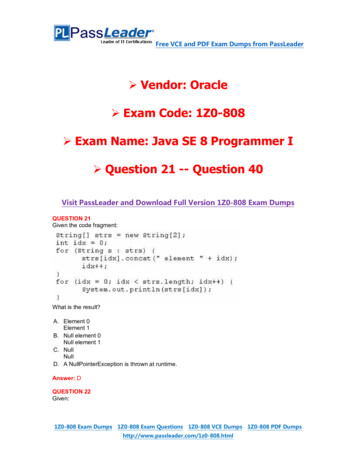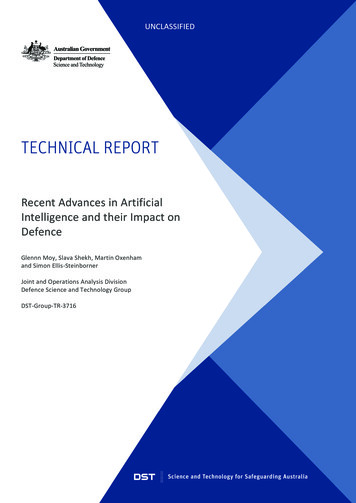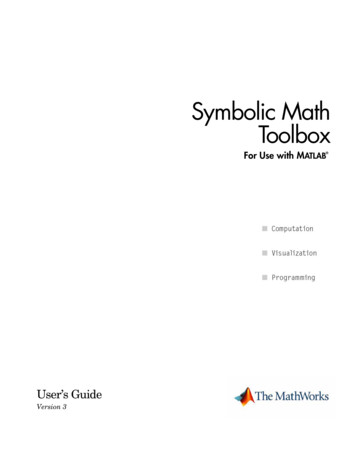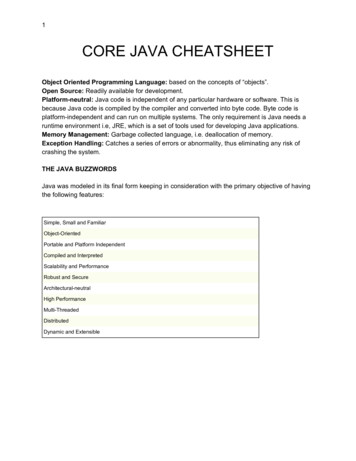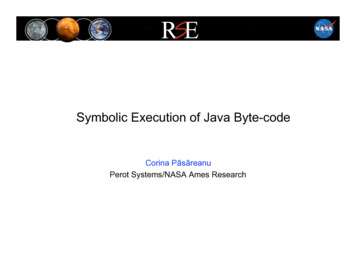
Transcription
Symbolic Execution of Java Byte-codeCorina PãsãreanuPerot Systems/NASA Ames Research
ISSTA’08 paper:“Combining Unit-level Symbolic Execution and System-level Concrete Execution forTesting NASA Software”Corina Pãsãreanu, Peter Mehlitz, David Bushnell, Karen Gundy-Burlet, Michael Lowry (NASA Ames)Suzette Person (University of Nebraska, Lincoln)Mark Pape (NASA JSC)
Automatic Test Input Generation Objective:– Develop automated techniques for error detection in complex, flight control softwarefor manned space missions Solutions:– Model checking – automatic, exhaustive; suffers from scalability issues– Static analysis – automatic, scalable, exhaustive; reported errors may be spurious– Testing – reported errors are real; may miss errors; widely used Our solution: Symbolic Java PathFinder (Symbolic JPF)– Symbolic execution with model checking and constraint solving for automatic testinput generation– Generates test suites that obtain high coverage for flexible (user-definable)coverage metrics– During test generation process, checks for errors– Uses the analysis engine of the Ames JPF tool– Freely available at:http://javapathfinder.sourceforge.net (symbc extension)
Symbolic JPF Implements a non-standard interpreter of byte-codes– To enable JPF to perform symbolic analysis Symbolic information:– Stored in attributes associated with the program data– Propagated dynamically during symbolic execution Handles:– Mixed integer/real constraints– Complex Math functions– Pre-conditions, multithreading Allows for mixed concrete and symbolic execution– Start symbolic execution at any point in the program and at any time duringexecution– Dynamic modification of execution semantics– Changing mid-stream from concrete to symbolic execution Application:– Testing a prototype NASA flight software component– Found serious bug that resulted in design changes to the software
Background: Model Checking vs. Testing/SimulationFSMOKSimulation/Testing error Model individual statemachines for subsystems /featuresSimulation/Testing:–– OKModel Checking––error tracespecificationModel Checking:–FSMLine 5: Line 12: Line 41: Line 47: Checks only some of thesystem executionsMay miss errors–Automatically combinesbehavior of state machinesExhaustively explores allexecutions in a systematicwayHandles millions ofcombinations – hard toperform by humansReports errors as tracesand simulates them onsystem models
Background: Java PathFinder (JPF) Explicit state model checker for Java bytecode– Built on top of custom made Java virtual machine Focus is on finding bugs– Concurrency related: deadlocks, (races), missed signals etc.– Java runtime related: unhandled exceptions, heap usage, (cycle budgets)– Application specific assertionsJPF uses a variety of scalability enhancing mechanisms– user extensible state abstraction & matching– on-the-fly partial order reduction– configurable search strategies– user definable heuristics (searches, choice generators)Recipient of NASA “Turning Goals into Reality” Award, 2003.Open sourced:– javapathfinder.sourceforge.net – 14000 downloads since publication Largest application:– Fujitsu (one million lines of code)
Background: Symbolic Execution King [Comm. ACM 1976] Analysis of programs with unspecified inputs– Execute a program on symbolic inputs Symbolic states represent sets of concrete states For each path, build a path condition– Condition on inputs – for the execution to follow that path– Check path condition satisfiability – explore only feasible paths Symbolic state– Symbolic values/expressions for variables– Path condition– Program counter
Example – Standard ExecutionCode that swaps 2 integersConcrete Execution Pathint x, y;x 1, y 0if (x y) {1 0 ? truex x y;x 1 0 1y x – y;y 1–0 1x x – y;x 1–1 0if (x y)0 1 ? falseassert false;}
Example – Symbolic ExecutionCode that swaps 2 integers:Symbolic Execution Tree:path conditionint x, y;if (x y) {[PC:true]x X,y Y[PC:true] X Y ?truefalsex x y;[PC:X Y]x X Yy x – y;[PC:X Y]y X Y–Y Xx x – y;[PC:X Y]x X Y–X Yif (x y)[PC:X Y]Y X ?assert false;}[PC:X Y]ENDfalse[PC:X Y Y X]ENDtrue[PC:X Y Y X]ENDFalse!Solve path conditions test inputs
Symbolic JPF JPF search engine used– To generate and explore the symbolic execution tree– Also used to analyze thread inter-leavings and other forms of nondeterminism that might be present in the code– No state matching performed In general, un-decidable– To limit the (possibly) infinite symbolic search state space resulting fromloops, we put a limit on The model checker’s search depth or The number of constraints in the path condition Off-the-shelf decision procedures/constraint solvers used to checkpath conditions– Model checker backtracks if path condition becomes infeasible– Generic interface for multiple decision procedures Choco (for linear/non-linear integer/real constraints, mixed / IASolver (for interval arithmetic)http://www.cs.brandeis.edu/ tim/Applets/IAsolver.html
Implementation Key mechanisms:–JPF’s bytecode instruction factory –Replace or extend standard concreteexecution semantics of byte-codes withnon-standard symbolic executionAttributes associated w/ program state Stack operands, fields, local variablesStore symbolic informationPropagated as needed during symbolicexecutionOther mechanisms:–Choice generators: –For handling branching conditionsduring symbolic executionListeners: –JPF Structure:For printing results of symbolic analysis(method summaries)For enabling dynamic change ofexecution semantics (from concrete tosymbolic)Native peers: For modeling native libraries, e.g.capture Math library calls and sendthem to the constraint solverInstructionFactory
An Instruction Factory for Symbolic Execution of Byte-codesWe ins instructions for the symbolicinterpretation of byte-codesNew Instruction classes derived fromJPF’s coreConditionally add new functionality;otherwise delegate to super-classesApproach enables simultaneousconcrete/symbolic executionJPF core:–––Implements concrete execution semantics based onstack machine modelFor each method that is executed, maintains a set ofInstruction objects created from the method bytecodesUses abstract factory design pattern to instantiateInstruction objects
Attributes for Storing Symbolic Information Used previous experimental JPF extensionof slot attributes– Generalized this mechanism to include fieldattributesAttributes are used to store symbolic valuesand expressions created during symbolicexecutionAttribute manipulation done mainly insideJPF core–– Additional, state-stored info associated withlocals & operands on stack frameWe only needed to override instructionclasses that create/modify symbolicinformationE.g. numeric, compare-and-branch, typeconversion operationsSufficiently general to allow arbitrary valueand variable attributes––Could be used for implementing otheranalysesE.g. keep track of physical dimensions andnumeric error bounds or perform concolicexecutionProgram state:–A call stack/thread: ––Stack frames/executed methodsStack frame: locals & operandsThe heap (values of fields)Scheduling information
Handling Branching Conditions Symbolic execution of branching conditions involves:–––––Creation of a non-deterministic choice in JPF’s searchPath condition associated with each choiceAdd condition (or its negation) to the corresponding path conditionCheck satisfiability (with Choco or IASolver)If un-satisfiable, instruct JPF to backtrack Created new choice generatorpublic class PCChoiceGeneratorextends IntIntervalGenerator {PathCondition[] PC; }
Example: IADDConcrete execution of IADD byte-code:public class IADD extendsInstruction { public Instruction execute( ThreadInfo th){int v1 th.pop();int v2 th.pop();th.push(v1 v2, );return getNext(th);}}Symbolic execution of IADD byte-code:public class IADD extends .bytecode.IADD { public Instruction execute( ThreadInfo th){Expression sym v1 .getOperandAttr(0);Expression sym v2 .getOperandAttr(1);if (sym v1 null && sym v2 null)// both values are concretereturn super.execute( th);else {int v1 th.pop();int v2 th.pop();th.push(0, ); // don’t care .setOperandAttr(Expression. plus(sym v1,sym v2));return getNext(th);}}}
Example: IFGEConcrete execution of IFGE byte-code:public class IFGE extendsInstruction { public Instruction execute( ThreadInfo th){cond (th.pop() 0);if (cond)next getTarget();elsenext getNext(th);return next;}}Symbolic execution of IFGE byte-code:public class IFGE extends .bytecode.IFGE { public Instruction execute( ThreadInfo th){Expression sym v .getOperandAttr();if (sym v null)// the condition is concretereturn super.execute( th);else {PCChoiceGen cg new PCChoiceGen(2); cond cg.getNextChoice() 0?false:true;if (cond) {pc. add GE(sym v,0);next getTarget();}else {pc. add LT(sym v,0);next getNext(th);}if (!pc.satisfiable()) // JPF backtrackelse cg.setPC(pc);return next;} } }
How to Execute a Method SymbolicallyJPF run configuration: vm.insn factory.class gov.nasa.jpf.symbc.SymbolicInstructionFactory jpf.listener gov.nasa.jpf.symbc.SymbolicListenerPrint PCs andmethod summaries vm.peer packages gov.nasa.jpf.symbc:gov.nasa.jpf.jvm symbolic.dp iasolverUse symbolic peerpackage for Math libraryUse IASolver as adecision procedure symbolic.method UnitUnderTest(sym#sym#con)MainInstruct JPF to usesymbolic byte-code setMethod to be executed symbolically(3rd parameter left concrete)Main application classcontaining method under testSymbolic input globals (fields) and method pre-conditions can bespecified via user annotations
“Any Time” Symbolic Execution Symbolic execution––– Any time symbolic execution– Use specialized listener to monitorconcrete execution and triggersymbolic execution based on certainconditionsUnit level analysis in realistic contexts– Can start at any point in the programCan use mixed symbolic and concreteinputsNo special test driver needed –sufficient to have an executableprogram that uses the method/codeunder testUse concrete system-level execution toset-up environment for unit-levelsymbolic analysisApplications:––Exercise deep system executionsExtend/modify existing tests: e.g. testsequence generation for Javacontainers
Case Study:Onboard Abort Executive (OAE) Prototype for CEV ascent abort handling beingdeveloped by JSC GN&C Currently test generation is done by hand by JSCengineers JSC GN&C requires different kinds of requirementand code coverage for its test suite:––––Abort coverage, flight rule coverageCombinations of aborts and flight rules coverageBranch coverageMultiple/single failures
OAE StructureInputsChecks Flight Rulesto see if an abort must occurSelect Feasible AbortsPick Highest Ranked Abort
Results for OAE Baseline– Manual testing: time consuming ( 1 week)– Guided random testing could not cover all aborts Symbolic JPF–––––––– Generates tests to cover all aborts and flight rulesTotal execution time is 1 minTest cases: 151 (some combinations infeasible)Errors: 1 (flight rules broken but no abort picked)Found major bug in new version of OAEFlight Rules: 27 / 27 coveredAborts: 7 / 7 coveredSize of input data: 27 values per test caseFlexibility– Initially generated “minimal” set of test cases violating multiple flight rules– OAE currently designed to handle single flight rule violations– Modified algorithms to generate such test cases
Generated Test Cases and ConstraintsTest cases:// Covers Rule: FR A 2 A 2 B 1: Low Pressure Oxodizer Turbopump speed limit exceeded// Output: Abort:IBBCaseNum 1;CaseLine in.stage speed 3621.0;CaseTime 57.0-102.0;// Covers Rule: FR A 2 A 2 A: Fuel injector pressure limit exceeded// Output: Abort:IBBCaseNum 3;CaseLine in.stage pres 4301.0;CaseTime 57.0-102.0; Constraints://Rule: FR A 2 A 1 A: stage1 engine chamber pressure limit exceeded Abort:IAPC ( 60 constraints):in.geod alt(9000) 120000 && in.geod alt(9000) 38000 && in.geod alt(9000) 10000 &&in.pres rate(-2) -2 && in.pres rate(-2) -15 &&in.roll rate(40) 50 && in.yaw rate(31) 41 && in.pitch rate(70) 100 &&
Integration with End-to-end Simulation Input data is constrained by environment/physical laws– Example: inertial velocity can not be 24000 ft/s when the geodeticaltitude is 0 ft– Need to encode these constraints explicitly Use simulation runs to get data correlations– As a result, we eliminated some test cases that were impossible due tophysical laws, for example Simulation environment: ANTARES– Advanced NASA Technology ARchitecture for Exploration Studies– Used for spacecraft design assessment, performance analysis,requirements validation, Hardware in the loop and Human in the looptesting Integration– System level simulations with ANTARES with– Unit level symbolic analysis
Using System Simulations to Determine Unit Pre-Conditions System simulation with ANTARES:–––Set-up input fileSpecify log file with variables to belogged during the runMonte Carlo simulations File with designated input variablesTheir probability distributionsNo. of cases to run while sampling fromprobability distributionsCorrelation analysis:–––Determine ranges for unit inputsTreatment learner [Menzies & Hu, 2003]Daikon invariant detector
Comparison with Our Previous Work JPF– SE [TACAS’07]:– http://javapathfinder.sourceforge.net (symbolic extension)– Worked by code instrumentation (partially automated)– Quite general but may result in sub-optimal execution For each instrumented byte-code, JPF needed to check a set of byte-codesrepresenting the symbolic counterpart– Required an approximate static type propagation to determine which byte-codeto instrument [Anand et al.TACAS’07] No longer needed in the new framework, since symbolic information is propagateddynamically Symbolic JPF always maintains the most precise information about the symbolic natureof the data– Generalized symbolic execution/lazy initialization [TACAS’03, SPIN’04] Handles input data structures, arrays Plan to move it into Symbolic JPF this summer– Interfaced with multiple decision procedures (Omega, CVC3/CVCLite, STP,Yices) via generic interface Created generic interface in Symbolic JPF Plan to add multiple decision procedures soon– Plan to add functionality of JPF—SE to Symbolic JPF
Related Work Model checking for test input generation [Gargantini & Heitmeyer ESEC/FSE’99, Heimdahl et al.FATES’03, Hong et al. TACAS’02]– Extended Static Checker [Flanagan et al. PLDI’02]– DART/CUTE/jCUTE Can not handle multi-threadingPerforms symbolic execution along concrete executionWe use concrete execution to set-up symbolic executionExecution Generated Test Cases [Cadar & Engler SPIN’05]Other hybrid approaches:–– Similar to JPF—SE, uses “lazier” approachConcolic execution [Godefroid et al. PLDI’05, Sen et al. ESEC/FSE’05]–––– Context of an empirical comparative studyExperimental implementation of symbolic execution in JPF via changing all the byte-codesDid not use attributes, instruction factoryInteger symbolic inputs (used CVCLite)Bogor/Kiasan [ASE’06]– Dedicated symbolic execution tool for test sequence generationPerforms subsumption checking for symbolic statesSymclat [d’Amorim et al. ASE’06]–––– Checks light-weight properties of JavaSymstra [Xie et al. TACAS’05]–– BLAST, SLAM Testing, abstraction, theorem proving: better together! [Yorsh et al. ISSTA’06]SYNERGY: a new algorithm for property checking [Gulavi et al. FSE’06]
Conclusion and Future Plans Symbolic JPF––– Any-time symbolic executionIntegration with system level simulation– Use system level Monte Carlo simulation to obtain ranges for inputsApplication to prototype flight component– Non-standard interpretation of byte-codesSymbolic information propagated via attributes associated with program variables, operands, etc.Available from javapathfinder.sourceforge.net , symbc extensionFound major bugCurrent/Future work:––––––Test input generation for UML Statecharts; for Simulink/Stateflow/Embedded MatlabApply to NASA softwareTighter integration with system level simulationMore decision proceduresUse symbolic execution for differential analysisCompositional analysis – Use symbolic execution to compute procedure summariesParallel symbolic executionJPF in Google summer of code––Generalized symbolic executionGenerate/extend test sequences
Questions?
Background: Java PathFinder (JPF) Explicit state model checker for Java bytecode -Built on top of custom made Java virtual machine Focus is on finding bugs -Concurrency related: deadlocks, (races), missed signals etc. -Java runtime related: unhandled exceptions, heap usage, (cycle budgets) -Application specific assertions


